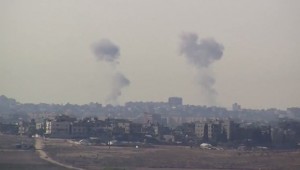For Iran and the Assad regime, intermission is over. The swift ending of the Gaza conflict is likely to thrust the bloodshed in Syria and the Iranian nuclear crisis back onto center stage, with an ever-invigorated Western-Arab alliance raising the curtain and directing the spotlight. Yet, in their overly-romantic portrayal of successful U.S. shuttle diplomacy and Egypt’s emergence as a responsible mediator, global punditry has underestimated the Ayatollahs’ continued ability to plunge the Gaza Strip back into chaos at their leisure.

Iran purposefully and undoubtedly fired the first shots of this latest escalation, which began four days prior to Israel’s assassination of Hamas leader Ahmed Jabari on November 14. On November 10, militants from the Iranian-backed Popular Resistance Committees (PRC) fired an advanced Kornet missile at an IDF border patrol, igniting four days of hostilities between Israel and other Gaza-based militant groups, primarily Hamas and Islamic Jihad. The use of such a highly accurate weapon was a game changer, prompting the IDF to plan Jabari’s killing soon after as a response.
While alliances between militant groups in the Gaza Strip are about as stable as quicksand, Israel has long maintained that it holds Hamas responsible for any violence emanating from the coastal enclave. This includes attacks from the PRC, whose successful use of a highly-sophisticated Kornet missile underscores just how advanced even fringe militant groups in the Gaza Strip have become under Iranian direction.
Under its ceasefire obligations, Hamas’ security forces are now tasked with preventing up to a dozen heavily armed militant groups, all more extremist than Hamas itself, from provoking another destructive Israeli operation. After the conclusion of Operation Cast Lead in January 2009, Hamas established a counter-guerrilla force specifically designed to thwart rocket attacks from the PRC, the Islamic Jihad, and al-Qaeda-inspired groups, many of which had become the focus of Iranian smuggling efforts.
For roughly two years, Hamas’ security forces prevented another outbreak of hostilities in the Gaza Strip. Amidst the instability of the Arab Spring, however, these groups began to grow bolder and more heavily armed, challenging Hamas to the point where tolerating their attacks on Israel became more politically beneficial than combating them.
After the conclusion of Israel’s Operation Pillar of Defense, this cycle of extremism is likely to repeat itself at a much more rapid pace. While Hamas may be falling under the increasing influence of Egypt, Turkey, and Qatar, the extremist Islamic Jihad and PRC continue to auction off their loyalty to the highest bidder — anyone wishing to fund their uncompromising efforts to destroy the State of Israel. As such, their members continue to travel to Iran to train with the most advanced Russian-made weapons money can buy, while acquiring the knowledge to construct long-range Fajr rockets in-house, deep underneath mosques and schools in the Gaza Strip.
Despite Egypt’s newly crowned role as a stabilizing force in the region, ongoing domestic civil unrest continues to occupy its already weakened security apparatus. The latest wave of anti-Muslim Brotherhood riots have not only embarrassed President Morsi, but are further expected to hinder efforts to prevent determined Iranian-funded smugglers from Sudan and Libya from reaching tunnels near the Gaza border. Hamas itself isn’t likely to turn down smuggled Iranian arms for use in a future conflict. During a recent interview with the Associated Press, Hamas’ Deputy Politburo Chief Moussa Abu Marzouk confirmed his faction has no intention of halting weapons smuggling or ceasing weapons production inside the Gaza Strip.
Indeed, even as the West continues to impose harsher economic sanctions, Iran’s investment in the Gaza Strip continues to pay off. For eight days, Israel’s pinpoint air strikes had practically emptied Syria of foreign coverage, with correspondents from CNN to Al Jazeera pouring in through the Rafah border crossing to cover another armed conflict between Israel and the Palestinians. In no small development, a report leaked from the IAEA during the fighting which exposed Iran’s ability to double uranium enrichment production at its covert Fordow facility, barely made headlines — even in Israel.
There should be little doubt that prolonging the Gaza conflict would have served Iranian interests. While Operation Pillar of Defense stopped short of the distracting ground operation the Ayatollahs had likely hoped for, they still maintain a plethora of willing proxies capable of executing another provocation and spurring another globally captivating armed conflict.
With P.M. Benjamin Netanyahu and F.M. Avigdor Liberman equally determined to assure their constituents of Israel’s deterrence ahead of elections in January, another destabilizing provocation may just be too tempting — and beneficial — for the Iranians to pass up.
Concerned about future outbreaks of violence in southern Israel? Consult with us for intelligence coverage for the MENA region.